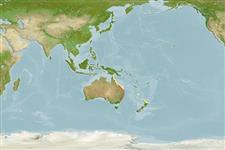Teleostei (teleosts) >
Pleuronectiformes (Flatfishes) >
Paralichthyidae (Large-tooth flounders)
Etymology: Pseudorhombus: Greek, pseudes = false + Greek, rhombos = paralelogram (Ref. 45335).
More on author: Waite.
Environment: milieu / climate zone / depth range / distribution range
Ecology
Marine; demersal; depth range 10 - 20 m (Ref. 9774). Temperate
Southwest Pacific: southeastern Australia northward to southern Queensland.
Size / Weight / Age
Maturity: Lm ? range ? - ? cm
Max length : 25.0 cm SL male/unsexed; (Ref. 9774)
Dorsal spines (total): 0; Dorsal soft rays (total): 74 - 80; Anal spines: 0; Anal soft rays: 58 - 61. Body brownish with 3 ocelli above and below lateral line, and small dark rings and blotches scattered on body and median fins. Body elliptical, its depth 2.1 to 2.3 times in SL. Head length 4.1 to 4.4 times in SL. Upper profile of head with shallow notch in front of upper eye. Snout slightly protruded, shorter than eye diameter, upper-eye diameter 3.8 to 5.2 times in head length. Maxilla extending almost below middle of lower eye. Upper-jaw length 3.9 to 4.6 times in head length. Teeth in both jaws small, close-set, no enlarged canines. Gill rakers slender and rather long. Scales usually cycloid on both sides, but sometimes weakly ctenoid on anterior part of body on eyed side. Pectoral fin on eyed side with 11 or 12 rays. (Ref 9774).
Inhabits sand and mud bottoms. Feeds on small benthic animals. Caught mainly with prawn and bottom trawls.
Life cycle and mating behavior
Maturity | Reproduction | Spawning | Eggs | Fecundity | Larvae
Distinct pairing (Ref. 205).
Amaoka, K. and D.A. Hensley, 2001. Paralichthyidae. Sand flounders. p. 3842-3862. In K.E. Carpenter and V. Niem (eds.) FAO species identification guide for fishery purposes. The living marine resources of the Western Central Pacific. Vol. 6. Bony fishes part 4 (Labridae to Latimeriidae), estuarine crocodiles. FAO, Rome. (Ref. 9774)
IUCN Red List Status (Ref. 130435: Version 2024-2)
Threat to humans
Harmless
Human uses
Fisheries: commercial
Tools
Special reports
Download XML
Internet sources
Estimates based on models
Preferred temperature (Ref.
123201): 20.4 - 25.7, mean 24.7 °C (based on 148 cells).
Phylogenetic diversity index (Ref.
82804): PD
50 = 0.5000 [Uniqueness, from 0.5 = low to 2.0 = high].
Bayesian length-weight: a=0.00724 (0.00338 - 0.01553), b=3.17 (3.00 - 3.34), in cm total length, based on LWR estimates for this Genus-body shape (Ref.
93245).
Trophic level (Ref.
69278): 3.5 ±0.37 se; based on food items.
Resilience (Ref.
120179): High, minimum population doubling time less than 15 months (Preliminary K or Fecundity.).
Fishing Vulnerability (Ref.
59153): Low vulnerability (21 of 100).
